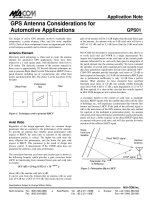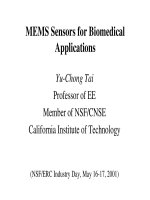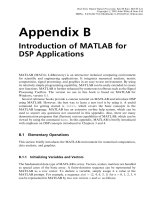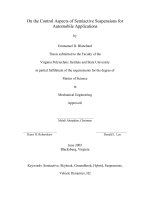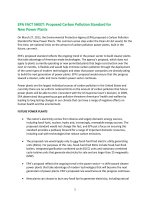- Trang chủ >>
- Khoa Học Tự Nhiên >>
- Vật lý
highly - ordered carbon nanotube arrays for electronics applications
Bạn đang xem bản rút gọn của tài liệu. Xem và tải ngay bản đầy đủ của tài liệu tại đây (628.69 KB, 3 trang )
Highly-ordered carbon nanotube arrays for electronics applications
J. Li, C. Papadopoulos, and J. M. Xu
a)
Department of Electrical and Computer Engineering, University of Toronto, Toronto M5S 3G4, Canada
M. Moskovits
Department of Chemistry, University of Toronto, Toronto M5S 3H6, Canada
͑Received 1 March 1999; accepted for publication 23 May 1999͒
Highly-ordered arrays of parallel carbon nanotubes were grown by pyrolysis of acetylene on cobalt
within a hexagonal close-packed nanochannel alumina template at 650 °C. The nanotubes are
characterized by a narrow size distribution, large scale periodicity, and high densities. Using this
method ordered nanotubes with diameters from 10 nm to several hundred nm and lengths up to 100
m can be produced. The high level of ordering and uniformity in these arrays is useful for
applications in data storage, field emission displays and sensors, and offers the prospect of deriving
computational functions from the collective behavior of symmetrically coupled nanotubes. The
fabrication method used is compatible with standard lithographic processes and thus enables future
integration of such periodic carbon nanotube arrays with silicon microelectronics. © 1999
American Institute of Physics. ͓S0003-6951͑99͒01929-4͔
Carbon nanotubes
1
are among the most promising mate-
rials anticipated to impact future nanotechnology. Their
unique structural and electronic properties
2,3
have generated
great interest for use in a broad range of potential
nanodevices.
4–7
Most of these applications will require a fab-
rication method capable of producing uniform carbon nano-
tubes with well-defined and controllable properties reproduc-
ibly. In addition, electronic and photonic devices such as
field emission displays and data storage
8,9
would need high
density, well-ordered nanotube arrays. While efforts to fab-
ricate high-quality crystalline ropes or bundles of carbon
nanotubes
10
and aligned arrays of isolated carbon
nanotubes
11–14
have been successful, to date it is still a chal-
lenge to produce arrays of isolated carbon nanotubes with
uniform diameters and periodic arrangement to meet device
requirements. In this letter, we describe a method for fabri-
cating large arrays of parallel carbon nanotubes with an un-
precedented level of periodicity and uniformity by pyrolysis
of acetylene on cobalt within a hexagonal close-packed
nanochannel alumina ͑NCA͒ template.
The method we used is based on template growth, re-
cently used by us and a rapidly increasing number of work-
ers, as a possible alternative route to the future nanofabrica-
tion of electronic devices.
8
When compared with mainstream
semiconductor fabrication techniques this template method
has the important advantages of being nonlithographic and
does not involve a cleanroom process. In addition, the
method is not material specific; we have been successful in
fabricating semiconductor, metallic and magnetic nanowire
and nanodot arrays using related template-based methods.
8
Here, the template approach was extended to produce peri-
odic carbon nanotube arrays by first electrochemically de-
positing a small amount of cobalt into the pores of a hexago-
nally ordered nanochannel alumina template and then
growing carbon nanotubes by pyrolysis of acetylene under
cobalt catalysis in the nanochannels.
An illustration of a typical fabrication process flow is
shown in Fig. 1͑a͒. The process begins with the anodization
of high purity ͑99.999%͒ aluminum on a desired substrate. It
has been observed
15
that under appropriate anodizing condi-
tions the pores of the anodic alumina film can self-organize
into a highly ordered hexagonal array of parallel vertically-
oriented pores. After subsequent investigations,
16
it is now
well established that by varying anodizing conditions hex-
agonal close-packed arrays with selectable diameters, densi-
ties and lengths can be formed defect-free over large
areas.
17–19
The scanning electron microscope ͑SEM͒͑Hitachi
S-4500͒ images in Figs. 2͑a͒ and 2͑b͒ show results of a two-
step anodization method that was used to create a NCA tem-
plate consisting of a hexagonal array of 32 nm diameter
channels, 6
m in length, by anodizing an aluminum sheet in
a 0.3 M oxalic acid solution at 15 °C under a constant volt-
age of 40 V. The next step is to electrochemically deposit a
a͒
Electronic mail:
FIG. 1. ͑a͒ Schematic of fabrication process. ͑b͒ SEM image of the resulting
hexagonally ordered array of carbon nanotubes fabricated using method in
͑a͒.
APPLIED PHYSICS LETTERS VOLUME 75, NUMBER 3 19 JULY 1999
3670003-6951/99/75(3)/367/3/$15.00 © 1999 American Institute of Physics
Downloaded 12 Dec 2010 to 115.145.195.177. Redistribution subject to AIP license or copyright; see />small amount of cobalt catalyst into the bottom of the tem-
plate channels
8,10
͓Fig. 1͑a͒, center͔. The ordered array of
nanotubes are grown by first reducing the catalyst by heating
the cobalt-loaded templates in a tube furnace at 600 °C for
4–5 h under a CO flow ͑100 cm
3
min
Ϫ1
͒. The CO flow is
then replaced by a mixture of 10% acetylene in nitrogen at a
flow rate of 100 cm
3
min
Ϫ1
͓Fig. 1͑a͒, right͔. In a typical
experiment, the acetylene flow is maintained for2hat
650 °C. The samples are then annealed in nitrogen for 15 h at
the same temperature. An SEM image of a highly ordered
carbon nanotube array formed in this way is shown in Fig.
1͑b͒.
The resultant carbon nanotube arrays were characterized
using SEM. Figures 3͑a͒ and 3͑b͒ show SEM micrographs of
carbon nanotube arrays which have been ion milled to re-
move residual amorphous carbon from the template surface.
The tubes in Fig. 3͑a͒ were partially exposed by etching the
alumina matrix using a mixture of phosphoric and chromic
acid. The SEM micrographs show several important features
of the carbon nanotube arrays produced by this technique.
First, all of the nanotubes are parallel to each other and per-
pendicular to the template forming a periodic hexagonal
close-packed array. Second, the nanotubes are of uniform
length and are open ended. Third, each pore of the template
is filled with one nanotube, which defines the tube diameter.
In addition, the tube diameter distribution throughout the ar-
ray is narrow, typically 5% of the mean diameter ͓Fig. 3͑a͒,
lower right inset͔—much narrower than heretofore reported
using other methods of nanotube array synthesis. The mean
diameter is approximately 47 nm; slightly larger than the
original template diameter due to uniform widening of the
template channels during processing.
10
Finally, the array has
a very high density of tubes—approximately 10
10
cm
Ϫ2
.
Further sample characterization was carried out using
transmission electron microscopy ͑TEM͒͑H7000 or JEOL
2021F͒ and electron diffraction. Figures 4͑a͒ shows a TEM
image of a carbon nanotube bundle which resulted from
completely dissolving the NCA matrix which supported the
nanotube array using a chemical etch. The nanotubes are
straight and have uniform lengths of 6
m equal to the thick-
ness of the NCA film in which they were grown. The elec-
tron diffraction patterns of the nanotube bundle ͓Fig. 4͑a͒,
inset͒ imply that the tubes are graphitic with an interwall
distance (d
002
) of approximately 3.6 Å, slightly larger than
the interplanar separation in graphite (d
002
ϭ 3.35 Å). The
tube wall thickness was found to lie in the range 4–5 nm,
suggesting the tubes are composed of approximately 12 gra-
phitic shells.
Several significant features of the nanotubes produced
by this fabrication technique are noted: Aside from the ex-
cellent uniformity in size and disposition, the nanotubes
FIG. 2. Nanochannel alumina templates. A two-step anodization method
͑see Ref. 19͒ was used to obtain the hexagonal close-packed nanochannel
alumina templates: ͑a͒ SEM image of etched alumina template after first
anodization showing top view of the resultant surface. ͑b͒ Second anodiza-
tion; The patterned surface from the previous step is anodized again under
identical conditions as in ͑a͒. The SEM image shows an oblique cross-
section view of the resultant highly-ordered nanochannel alumina having 6
m long channels, 32 nm in diameter with a density of approximately
10
10
cm
2
.
FIG. 3. Highly-ordered carbon nanotube arrays. ͑a͒ SEM image showing
oblique view of periodic carbon nanotube array. The inset at the lower left is
an enlarged view of the tubes. The inset at the lower right is a histogram of
the nanotube diameter showing a narrow size distribution around 47 nm. ͑b͒
Top-view SEM image of the carbon nanotubes showing hexagonal close-
packed geometry. The hexagonal cells have sides approximately 57 nm long
and the intercell spacing is 98 nm. The slight splitting of the tube ends and
the apparent increase in tube wall thickness is an artifact of the nonspecial-
ized ion-milling apparatus that was used in our experiments. The inset
shows a close-up view of a typical open-ended carbon nanotube in its hex-
agonal cell.
368 Appl. Phys. Lett., Vol. 75, No. 3, 19 July 1999 Li
et al.
Downloaded 12 Dec 2010 to 115.145.195.177. Redistribution subject to AIP license or copyright; see />grow naturally perpendicular to a rigid substrate without ex-
tra processing steps. In addition, this method of nanotube
array synthesis is not inherently area limited and can be
scaled up with the template size.
18
The approach of nanofab-
rication presented need not involve lithography and is there-
fore inexpensive. The gentle electrochemical methods used
and moderate growth temperature ͑650 °C͒ also make the
method compatible with standard lithographic processes
since the aluminum film used to form the NCA template can
be deposited and processed on a variety of surfaces including
standard silicon wafers. The controlled variation of the nano-
tube size, density, and array spacing depends on easily ad-
justable parameters such as the anodizing voltage, electrolyte
composition, and temperature resulting in ordered arrays
with selectable diameters ranging from approximately 10 nm
to several hundred nm and densities of up to 10
11
cm
Ϫ2
.
Tube lengths of up to 100
m can be obtained by varying the
length of the pores in the NCA template in which the nano-
tubes are grown, which can be achieved by varying the time
of anodization.
The above properties are important for fundamental and
applied purposes; Precise and reproducible control of nano-
tube dimensions should allow the reliable study of their
physical properties. In addition, our technique arranges indi-
vidual carbon nanotubes in a periodic superstructure creating
the unique possibility of studying novel mesoscopic collec-
tive excitations and cooperative phenomena due to electro-
magnetic coupling of tubes in the array.
20
Finally, our
method allows inexpensive production of large arrays of or-
dered carbon nanotubes with controllable dimensions needed
for practical applications.
The physical mechanism of carbon nanotube growth by
the catalytic decomposition of organic vapors has been pos-
tulated as either base or tip growth.
21
At this stage an expla-
nation of the nanotube growth mechanism within NCA tem-
plates must remain speculative, but some observations can
help point the way to an eventually understanding of the
growth process; using SEM we have observed residual co-
balt catalyst in the base of the tubes ͓Fig. 4͑b͔͒ indicating
that a tip growth mechanism cannot be entirely responsible
for the tube growth. In addition, the appearance of catalyst-
free tube ends in the SEM images further argues for base
growth. However, the situation is complicated by the pres-
ence of the alumina template which may also act as a catalyst
in the nanotube growth.
10
Determining the exact nature of
the growth process will require further detailed study.
In summary, we have synthesized highly-ordered carbon
nanotube arrays over large areas by pyrolysis of acetylene on
cobalt within a hexagonally-disposed nanochannel alumina
template. The method presented in this letter offers precise
control of nanotube length ͑up to 100
m͒, diameter ͑ϳ10–
350 nm͒ and array density ͑up to 10
11
cm
Ϫ2
͒. These ex-
tremely uniform arrays could be used in a variety of appli-
cations including high-density data storage, inert membranes
for biomedical use, field emission displays, and infrared im-
aging detectors. Looking further, our method allows indi-
vidual carbon nanotube devices to be periodically assembled
into ultradense nanoelectronic networks whose collective be-
havior could then be used to perform computational func-
tions.
The authors would like to thank A. Rakitin, A. J. Ben-
nett, and D. Levner for valuable discussions. Support from
NSERC, OCMR, and Nortel is greatly appreciated.
1
S. Iijima, Nature ͑London͒ 354,56͑1991͒.
2
C. T. White, D. H. Robertson, and J. W. Mintmire, Phys. Rev. B 47, 5485
͑1993͒.
3
J. W. G. Wildoer, L. C. Venema, A. Rinzler, R. E. Smalley, and C.
Dekker, Nature ͑London͒ 391,59͑1998͒.
4
S. Frank, P. Poncharal, Z. L. Wang, and W. A. de Heer, Science 280, 1744
͑1998͒.
5
P. G. Collins, A. Zettl, H. Bando, A. Thess, and R. E. Smalley, Science
278, 100 ͑1997͒.
6
S. J. Tans, A. R. M. Vershuerent, and C. Dekker, Nature ͑London͒ 393,49
͑1998͒.
7
G. Che, B. B. Lakshmi, R. E. Fisher, and C. R. Martin, Nature ͑London͒
393, 346 ͑1998͒.
8
D. Routkevitch, A. A. Tager, J. Haruyama, D. Almawlawi, M. Moskovits,
and J. M. Xu, IEEE Trans. Electron Devices 43, 1646 ͑1996͒, and refer-
ences therein.
9
R. J. Tonucci, B. L. Justus, A. J. Campillo, and C. E. Ford, Science 258,
783 ͑1992͒.
10
A. Thess, R. Lee, P. Nikolaev, H. Dai, P. Petit, J. Robert, C. Xu, Y. Hee
Lee, S. Gon Kim, A. G. Rinzler, D. T. Colbert, G. E. Scuseria, D. To-
manek, J. E. Fischer, and R. E. Smalley, Science 273, 483 ͑1996͒.
11
J. Li, T. Haslett, and M. Moskovits, Chem. Mater. 10, 1963 ͑1998͒.
12
T. Kyotani, L. Tsai, and A. Tomita, Chem. Mater. 8, 2190 ͑1996͒.
13
W. Z. Li, S. S. Xie, L. X. Qian, B. H. Chang, B. S. Zou, W. Y. Zhuo, R.
A. Zhao, and G. Wang, Science 274, 1701 ͑1996͒.
14
Z. F. Ren, Z. P. Huang, J. W. Xu, J. H. Wang, P. Bush, M. P. Siegal, and
P. N. Provencio, Science 282,1105͑1998͒.
15
M. Konno, M. Shindo, S. Sugawara, and S. Saito, J. Membr. Sci. 37, 193
͑1988͒.
16
H. Masuda and K. Fukuda, Science 268, 1466 ͑1995͒.
17
A. P. Li, F. Muller, A. Birner, K. Nielsch, and U. Gosele, J. Appl. Phys.
84, 6023 ͑1998͒.
18
H. Masuda, H. Yamada, M. Satoh, and H. Asoh, Appl. Phys. Lett. 71,
2770 ͑1997͒.
19
H. Masuda and M. Satoh, Jpn. J. Appl. Phys., Part 2 35, L126 ͑1996͒.
20
R. Landauer, Solid State Commun. 95,7͑1995͒.
21
R. T. K. Baker, Carbon 27, 315 ͑1989͒.
FIG. 4. ͑a͒ TEM image of carbon nanotube bundle completely removed
from the NCA template. The nanotubes are very straight and have uniform
lengths of 6
m corresponding to the dimensions of the NCA template they
were grown in. The insets are electron diffraction patterns of the nanotubes.
͑b͒ Cross-section SEM image of the nanotube array partially exposed from
NCA template; the cobalt catalyst is at the base of the tubes separated from
the aluminum substrate. The inset is an enlarged view TEM image of a
single nanotube showing the cobalt particle at the base.
369Appl. Phys. Lett., Vol. 75, No. 3, 19 July 1999 Li
et al.
Downloaded 12 Dec 2010 to 115.145.195.177. Redistribution subject to AIP license or copyright; see />

